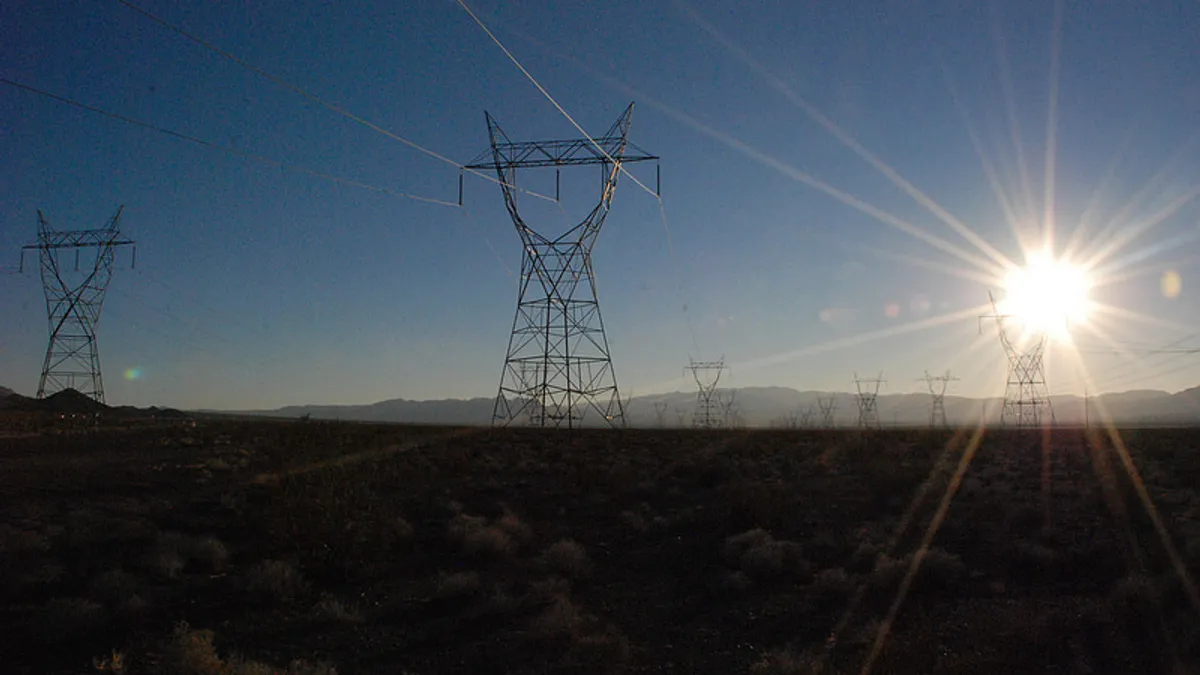Dive Brief:
- The Department of Energy announced $8.25 billion in loans available for transmission projects on Tuesday, as the White House released a fact sheet on the coordinated efforts between DOE and the Department of Transportation (DOT) to modernize the electric grid.
- The total included up to $5 billion in loan guarantees for innovative transmission projects, such as offshore wind, and projects sited on federally recognized tribal nations through DOE's Loan Program Office, along with up to $3.25 billion in the Western Area Power Administration's (WAPA) transmission infrastructure fund. The WAPA revolving loan program is designed to facilitate clean power in the West.
- That same day, Americans for a Clean Energy Grid (ACEG) published a report highlighting 22 different transmission projects that are "shovel-ready" to add renewable energy to the U.S. grid. The White House fact sheet cites the independent analysis as proof that construction-ready transmission projects would bring more than 60 GW of renewable energy online.
Dive Insight:
The Biden administration is working toward a promise of 100% clean energy by 2035, and expanding transmission to deliver renewable energy is a critical part of that effort, experts said during a webinar ACEG hosted on Tuesday.
"Transmission capacity must double or triple" to meet the Biden administration's plans, Yvonne McIntyre, director of federal electricity and utility policy for the Natural Resources Defense Council, said during the webinar.
The loans DOE identified are the "down payment" on federal efforts to modernize transmission, "but we need the American Jobs Plan to complete them," Energy Secretary Jennifer Granholm said in a press release.
Biden's American Jobs Plan calls for an immediate investment of $50 million in transportation projects and the creation of a $10 billion "national infrastructure bank" to fund public works. Granholm has been touting the plan, which the administration introduced earlier this month.
DOT announced on Tuesday its commitment to expedite siting and permitting of transmission lines along public highway infrastructure. The department issued guidance to help state transportation departments host transmission lines, build renewable energy and support electric vehicle (EV) charging.
Senate Republicans have put forth an infrastructure plan that does not mention transmission and the power grid, although Sen. Shelley Moore Capito, R-W. Va., who led the bill's unveiling, said spending on roads and highways could include EV infrastructure funds.
A transmission tax credit, such as the one proposed in legislation from Sen. Ron Wyden, D-Ore., chair of the Senate Finance Committee, continues to receive support as well.
The ACEG report outlines 22 projects that are ready for construction but anticipates that less than half will proceed in the near term "based on the many challenges that hinder transmission." The group calculates that the proposed 30% transmission tax credit from a separate legislation put forth by Sen. Martin Heinrich, D-N.M., would likely lead to a federal budget impact of under $5 billion, if measured from half of the expected $33 billion of project investments.
| Region | Miles | Cost (Billions) |
|---|---|---|
| New England | 150 | $1.6 |
| New York | 695 | $4.93 |
| Offshore | 30 | $1.9 |
| PJM | 73 | $1 |
| ERCOT-Southeast | 400 | $1.4 |
| MISO | 450 | $3.02 |
| SPP | 1180 | $3.5 |
| West | 4,945 | $15.93 |
| Total | 7,923 | $33.28 |
One project, Southern Cross transmission, would have brought "a couple thousand megawatts" into the Texas grid, "which would have gone a long way to relieve the problems that were faced in Texas recently with the freeze," Michael Garland, CEO of Pattern Energy, a developer of transmission projects, said during the webinar.
"It's my belief that 2 GW into Texas would have saved some lives," Rob Gramlich, founder and president of Grid Strategies and report co-author, said on the webinar. "These interregional projects are very hard to do from a business standpoint, but they provide incredible public benefit."
"We know we're gonna need... a better connected grid, the macro grid we've been talking about," Greg Wetstone, president and CEO of the American Council on Renewable Energy, said during the webinar.
The report also draws attention to the potential for the Federal Energy Regulatory Commission to reform transmission planning. FERC Chair Richard Glick has regularly named transmission policy reform a top priority for the commission.















